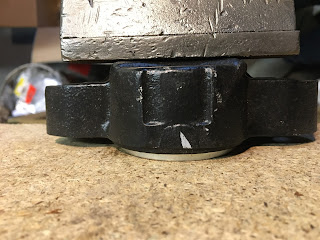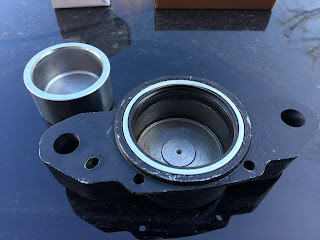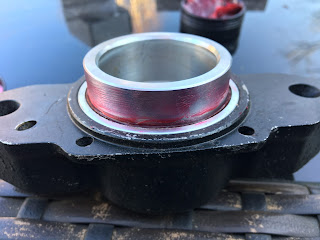When I took apart the front suspension and steering I noticed that the stub axle bushes were not fitted correctly. The grease holes didn't line up. So I had to remove them and buy new ones. The problem with that is you have to have the new bushes reamed so that the king pins sit and rotate perfectly.
I have a local company that has all the tools and has done it many times before, so made sense to me to get them to do it. I was really pleased when I got them back as they fitted really well. Money well spent.
You can see here the lower grease hole that allows for lubrication of the king pin. There is another one on the top bush.
Now they were ready to fit. First up you need to fit the dust shield with spring, which just slots into place.
Then you need to fit the stub axle on to the lower wishbone, which is held in place with this fulcrum pin. You need to check for excessive wear and make sure the threads are all in good condition.
The fulcrum pin needs to be lubricated with grease and so it is important that you grease it during the fitting.
There are two cork washers that need to be fitted.
Then you can screw in the fulcrum pin. What you will find is that if you tighten this up all the way the king pin will move out of centre to the right. You need to make sure the it is in the middle.
You can tell when it is in the correct place as it should look right but also you should be able to see the groove where the cotter pin slides in.
If you are replacing your cotter pins you need to file them down to fit, so that there is enough thread for the nut to screw on to.
Make sure that you don't over tighten this nut, it is very easy to do as the treads are delicate. The locking washer should hold it.
On the bottom of the stub axle fit the rubber seal.
Then slide the stub axle on to the king pin and check it all feels smooth and tight.
You can then screw in the plug and grease nipple to seal the fulcrum pin.
Next up is to start to fit the thrust washer and trunnion on top of the king pin and stub axle which will also attached to the front damper. In a perfect world you should then be able to tighten all the nuts and you're good to go, but sadly and in most cases that isn't the end of the set up.
The top nut that screws down on to the trunnion has a set torque. The idea is that when everything has been tightened correctly the stub axle will only turn left and right with the correct amount of resistance. But due to the tolerances involved being very small you might find that when tightened the stub axle moves up and down a little or the stub axle is hard to turn left or right, which isn't good for steering the car.
This is why you can buy shims to compensate for the tolerances that you have in your set up.
I know it is hard to see but the top photo is reading just over 9mm and the second one is 10mm. So that resulted in movement up and down in one of my stub axles as shown in the video below.
In order to stop this movement I had to add 3 shims on the top of the king pin. As it turned out the other side was perfect and needed no shims at all.
Is it important to note that you must fit the rubber buffer that supports the damper arm. Then you can continue with the trunnion. It is also important that you get the trunnion the right way round so NOT how I have it in the photo immediately below.
I bought new SuperPro bushes which fitted really well. Make sure you use the grease provided. Trunnion in this photo is the right way round.
Then you can fit the top fulcrum pin. You might want to try and have the groove facing upwards ready to fit this to the damper arm. Please note the trunnion in this photo is NOT the right way round.
It can be a bit of an effort to bring these two parts together, but they should go.
Please note the trunnion in this photo is NOT the right way round.
Then you can fit the bolt that screws into the damper. You need to align that to the groove in the fulcrum pin. You can now tighten the top fulcrum pin castle nut which needs a split pin. This is tightened to where the split pin hole is.
You can now connect the steering arm to the tie rod end of the steering column. I'll cover off wheel alignment in this post:
And then fit the dust shield.
I'll cover off fitting the spring in this post: Front Suspension Rebuild



















































































